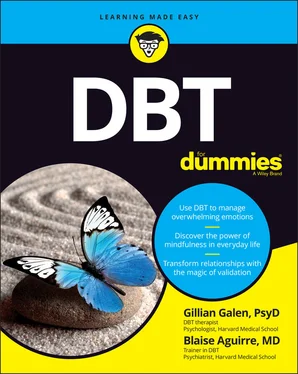NOT: As you ride the WAVE, remind yourself that you are not your emotions and that your emotions will not last forever. It may seem like a small semantic thing, but when you talk about your experience, it’s important to avoid saying “I am depressed” and instead say “I feel depressed.” When you indicate it as a feeling state, it signals to the brain that it’s something that changes. By definition, emotions change and fluctuate. The first statement communicates, “I am a person who is depressed; it is inherent to me and therefore is less likely to change.” It may seem small, but it makes a big difference when you’re working on experiencing emotions and allowing them to move through you. Sometimes when emotions are very intense, you may feel like they will never end. It’s important to note that primary emotions last an average of 90 seconds, which is far from forever, even if it feels like it.
Confronting Disproportionate Reactions
If you’re an emotionally sensitive person, by definition you feel things longer and deeper than the average person and you have a much slower return to baseline. This is simply your biology. You can think of it like the engine of a car. The engine in a Porsche and the engine in a Prius are very different in their capability to rapidly accelerate. What this means is that it isn’t uncommon for emotionally sensitive people to react more intensely and hold onto emotions longer. The problem with this is that it can increase your suffering and negatively impact your relationships.
People we work with have often said that they have been told that they are “too much” or that they always overreact. That kind of feedback can be very painful. If you struggle with this, the good news is that like a car with a fast engine, you can learn how to drive it; you can also learn to recognize when your reaction is too intense and regulate it. The following sections can help.
Realizing that your reaction may be overblown
If you’re an emotionally sensitive person, you need to accept, without judgment, that you may often have overblown reactions. Accepting this about some of your reactions will help you recognize when it happens, and that is the first step. In DBT, while we don’t love the term, we talk about two types of emotions, justified and unjustified. This may seem subjective, and in many ways it is. You’ll be the one who determines whether your emotions are justified or unjustified using a few guidelines from DBT. Again, this is not about judging your emotions, but about helping you cope when your emotions are leading to misery and suffering, and to then figure out what skills you can use.
 To answer this question, you want to ask yourself three questions:
To answer this question, you want to ask yourself three questions:
Does my emotion fit the situation, and does it make sense that this emotion is showing up right now?
Does the intensity to which I am feeling it make sense?
Does the duration that I am feeling it make sense?
 Sometimes it’s hard to answer these questions when you’re filled with strong emotions. Here is a helpful trick: We often ask our patients to think about people they know who they feel experience and regulate their emotions well and would provide a reasonable metric for comparison. It could be your group of friends, people you work with, or even other close or extended family members. Try to compare your answers to the preceding three question to theirs. Pick people who you think experience and regulate their emotions in a way that you could use as a model. This is not meant as a comparison that leaves you feeling bad about your emotions, but instead as a means of comparison that will guide your choice of skills. In Chapter 10, we give you some specific emotion regulation skills that you can use once you have identified whether your emotions are justified or unjustified.
Sometimes it’s hard to answer these questions when you’re filled with strong emotions. Here is a helpful trick: We often ask our patients to think about people they know who they feel experience and regulate their emotions well and would provide a reasonable metric for comparison. It could be your group of friends, people you work with, or even other close or extended family members. Try to compare your answers to the preceding three question to theirs. Pick people who you think experience and regulate their emotions in a way that you could use as a model. This is not meant as a comparison that leaves you feeling bad about your emotions, but instead as a means of comparison that will guide your choice of skills. In Chapter 10, we give you some specific emotion regulation skills that you can use once you have identified whether your emotions are justified or unjustified.
Getting from recognition to regulation
While some find that recognizing their emotions is the hardest part, others find figuring out what to do with them or finding the willingness to use a skill to be the most challenging part. We discuss more specific emotion regulation skills in Chapter 10. Once you recognize your emotions, you need to ask yourself what you want or need to do with them.
One of the most critical and sometimes hardest things to do is to validate your emotions. For many people who come to DBT, this is one of the hardest skills because for many years, they, and often their loved ones, have been invalidating their emotions. The key to validation is to remind yourself (and others if you’re validating them) what makes sense about how you feel. The NO in your SUN WAVE NO NOT (covered earlier in this chapter) helps you avoid the self-invalidation that may have become automatic.
 Validation, by definition, helps decrease the intensity of your emotion by reminding you that your emotions make sense. Invalidation, or telling yourself you shouldn’t feel a certain way, that you’re stupid or weak for feeling something, or even that you should just get over it, are some of the most effective ways to enhance the very feelings that are already painful and leading to suffering. Invalidation is a main ingredient of generating a sticky secondary emotion. (We discuss primary and secondary emotions earlier in this chapter.)
Validation, by definition, helps decrease the intensity of your emotion by reminding you that your emotions make sense. Invalidation, or telling yourself you shouldn’t feel a certain way, that you’re stupid or weak for feeling something, or even that you should just get over it, are some of the most effective ways to enhance the very feelings that are already painful and leading to suffering. Invalidation is a main ingredient of generating a sticky secondary emotion. (We discuss primary and secondary emotions earlier in this chapter.)
Asking a few helpful questions
 Once you’ve recognized and labeled your emotions, you may want to ask yourself some questions to help you think through what skills will be the most effective. We recommend that you practice doing this so that it becomes a habit. Consider asking yourself these questions:
Once you’ve recognized and labeled your emotions, you may want to ask yourself some questions to help you think through what skills will be the most effective. We recommend that you practice doing this so that it becomes a habit. Consider asking yourself these questions:
1 How can I validate my current emotion?
2 Do I want to tolerate and accept this emotion so I can ride it out like a wave?
3 Do I want to increase or decrease the intensity of this emotion?
4 Do I want to stay miserable?
5 Do I want to do something to make it worse?
We review many skills to help you tolerate, as well as increase and decrease, the intensity of your emotions in Part 3of this book.
 Often people get confused at question numbers four and five in the preceding list:
Often people get confused at question numbers four and five in the preceding list:
Sometimes, staying miserable for a period of time can be validating. It’s okay to do that. That being said, we include it as number four because we want that to be a choice made with intention and not a state that you find yourself stuck in, not realizing how you got there. You can think about it like this: It’s okay to throw yourself a pity party — sometimes we all just need that — but you need to know that you’re going to the party, so that after a reasonable period of time, you know how to leave.
Number five is there for similar reasons; it will help you avoid falling into the trap of making things worse. Remember, you can almost always make your situation and emotions worse. Our hope is that you learn this as an option so that you can experience this emotion less. It isn’t uncommon for this to happen in a split second and with little awareness. The idea is to slow yourself down. It may seem like an obvious example, but when you’re angry and you punch a wall, it may feel good in the moment when you get a huge rush of adrenaline, but then you just have a hole in the wall that you need to explain and then fix. You have worsened your problem, and if you’re like many people, you’ve piled on an intense feeling of shame.
Читать дальше

 To answer this question, you want to ask yourself three questions:
To answer this question, you want to ask yourself three questions: Sometimes it’s hard to answer these questions when you’re filled with strong emotions. Here is a helpful trick: We often ask our patients to think about people they know who they feel experience and regulate their emotions well and would provide a reasonable metric for comparison. It could be your group of friends, people you work with, or even other close or extended family members. Try to compare your answers to the preceding three question to theirs. Pick people who you think experience and regulate their emotions in a way that you could use as a model. This is not meant as a comparison that leaves you feeling bad about your emotions, but instead as a means of comparison that will guide your choice of skills. In Chapter 10, we give you some specific emotion regulation skills that you can use once you have identified whether your emotions are justified or unjustified.
Sometimes it’s hard to answer these questions when you’re filled with strong emotions. Here is a helpful trick: We often ask our patients to think about people they know who they feel experience and regulate their emotions well and would provide a reasonable metric for comparison. It could be your group of friends, people you work with, or even other close or extended family members. Try to compare your answers to the preceding three question to theirs. Pick people who you think experience and regulate their emotions in a way that you could use as a model. This is not meant as a comparison that leaves you feeling bad about your emotions, but instead as a means of comparison that will guide your choice of skills. In Chapter 10, we give you some specific emotion regulation skills that you can use once you have identified whether your emotions are justified or unjustified. Validation, by definition, helps decrease the intensity of your emotion by reminding you that your emotions make sense. Invalidation, or telling yourself you shouldn’t feel a certain way, that you’re stupid or weak for feeling something, or even that you should just get over it, are some of the most effective ways to enhance the very feelings that are already painful and leading to suffering. Invalidation is a main ingredient of generating a sticky secondary emotion. (We discuss primary and secondary emotions earlier in this chapter.)
Validation, by definition, helps decrease the intensity of your emotion by reminding you that your emotions make sense. Invalidation, or telling yourself you shouldn’t feel a certain way, that you’re stupid or weak for feeling something, or even that you should just get over it, are some of the most effective ways to enhance the very feelings that are already painful and leading to suffering. Invalidation is a main ingredient of generating a sticky secondary emotion. (We discuss primary and secondary emotions earlier in this chapter.)










